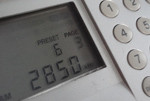 The organization that runs America’s international broadcasting services wants to build a transmitter in South Korea to give Voice of America and Radio Free Asia a better signal into the DPRK.
The organization that runs America’s international broadcasting services wants to build a transmitter in South Korea to give Voice of America and Radio Free Asia a better signal into the DPRK.
The Broadcasting Board of Governors disclosed the plan in its annual budget request, which was published on Wednesday.
The plan, if realized, could mean a substantially stronger and more reliable signal for the two stations, but is likely to attract jamming by North Korean authorities.
The BBG is seeking to construct a new medium wave transmitter in South Korea. This transmitter, optimally situated in a location near the border with North Korea, would be capable of sending a strong signal that would significantly enhance the BBG’s Korean Services’ capability to reach audiences. — BBG Fiscal Year 2014 Budget Request.
Both Voice of America and Radio Free Asia have broadcast their Korean language services on shortwave for years. Shortwave transmissions can easily cover all of the DPRK, but they are affected by atmospheric conditions so different frequencies need to be used at different times of day and year. They also require a shortwave radio.
In contrast, mediumwave coverage is much less prone to atmospheric interference and changes in a much more predictable way: at night signals bounce off the ionosphere and travel greater distances than during daylight. Mediumwave radios are also much more common.
For these reasons, mediumwave is desirable for broadcasting into North Korea, but getting on air in East Asia can be difficult because of the heavily regulated media scene.
In the last few years, Voice of America and Radio Free Asia have managed to put some of their programs on mediumwave by leasing time on two transmitters: the 1188kHz station of religious station Far East Broadcasting Co. (FEBC) in Seoul and the 648kHz transmitter of Voice of Russia near Vladivostok.
The envisaged new transmitter would probably cover a large portion of North Korea, from the border northwards.
North Korea would likely jam the frequency by deliberately broadcasting noise on the same frequency, but that’s often not completely successful — especially for the dedicated listener.
No further details of the plan were revealed in the budget filing.
BBG did report that radio remains the best way to reach North Koreans with news. The lack of Internet access in the DPRK means there isn’t a viable alternative for fast dissemination of information.
Both Voice of America and Radio Free Asia currently broadcast for five hours per day in Korean, with each retaining its own identity. Their programs are scheduled so that they don’t air at the same time.
VOA kicks off broadcasting at 9pm local time with three hours of programs until midnight. RFA then broadcasts through the night until 4am when VOA comes back on air until 6am. RFA puts out a final hour of programming between 6am and 7am.
At first those might seem like odd hours to be on the air, but foreign radio listening needs to be done in private at home, so nighttime or early morning broadcasts are preferred. Broadcasting overnight has the added benefit that radio wave propagation is generally better during the hours of darkness.
In its budget request, BBG asked for $2.15 million to run Radio Free Asia’s Korean service in the fiscal year, a drop of 2 percent from its current budget. RFA will see budget cuts to all its services in 2014, according to the budget, but those for the Korean service are among the smallest and nowhere near to 28 percent cut to Cambodian services.
The Voice of America budget does not break out the Korean service, but the East Asia and Pacific division in which it’s included will see its proposed 2014 budget unchanged at $33.3 million.
Here’s how the BBG explained the different identities and directions of each station:
In order to help audiences understand U.S. government policies and views, VOA Korean goes directly to key American policymakers on North Korea issues. Through its sources in the Administration, Congress, and the think tank community, VOA Korean consistently provides the latest and most authoritative news and analysis on U.S. policy towards North Korea, in the Korean language. To enhance its capabilities to reach North Koreans, VOA Korean is expanding its partnership with South Korean entities through program placements.
RFA Korean’s strength in surrogate reporting lies in its utilization of North Korean defectors. Working closely with an extensive network of contacts inside the target area and Chinese towns bordering North Korea, RFA Korean uses defectors to add value to broadcast content. The Service’s feature stories highlight the human rights situation both inside and outside North Korea, including in China, where many North Korean refugees stay in hiding. — BBG Fiscal Year 2014 Budget Request.



